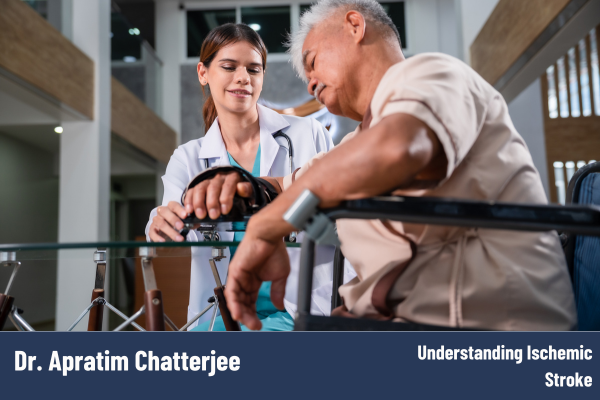Ischemic stroke, a leading cause of disability and death worldwide, occurs when blood flow to the brain is obstructed. Dr. Apratim Chatterjee, a renowned neurologist and neurosurgeon in South Kolkata, provides essential insights into this medical emergency, its causes, symptoms, and treatment options.
What is an Ischemic Stroke? An ischemic stroke happens when a blood vessel supplying blood to the brain is blocked by a clot. This interruption deprives brain cells of oxygen and nutrients, leading to cell death and brain damage.
Causes and Risk Factors The primary causes of ischemic stroke include:
- Thrombosis: Formation of a blood clot within a blood vessel in the brain.
- Embolism: A clot that forms elsewhere in the body and travels to the brain.
- Atherosclerosis: Narrowing of arteries due to plaque buildup.
Risk factors for ischemic stroke include:
- High Blood Pressure: The most significant risk factor.
- Diabetes: Increases the risk of stroke.
- High Cholesterol: Leads to plaque buildup in arteries.
- Smoking: Damages blood vessels and increases clot formation.
- Heart Disease: Conditions like atrial fibrillation can lead to blood clots.
Symptoms Recognizing stroke symptoms promptly can save lives and improve outcomes. Key symptoms include:
- Sudden numbness or weakness in the face, arm, or leg, particularly on one side of the body.
- Sudden confusion, trouble speaking, or understanding speech.
- Sudden trouble seeing in one or both eyes.
- Sudden difficulty walking, dizziness, or loss of balance and coordination.
- Sudden severe headache with no known cause.
Treatment Options Immediate treatment is crucial for ischemic stroke:
- Intravenous Thrombolysis: Administration of tissue plasminogen activator (tPA) to dissolve the clot, ideally within 4.5 hours of symptom onset.
- Mechanical Thrombectomy: A surgical procedure to remove the clot from the blocked artery, typically within 6 to 24 hours of symptom onset.
- Medications: Antiplatelet and anticoagulant drugs to prevent new clots.
- Rehabilitation: Physical, occupational, and speech therapy to regain lost functions.
Prevention Preventing ischemic stroke involves managing risk factors:
- Controlling high blood pressure and diabetes.
- Maintaining a healthy diet and regular exercise routine.
- Quitting smoking and reducing alcohol intake.
- Regular medical check-ups to monitor and manage health conditions.
Conclusion Dr. Apratim Chatterjee emphasizes the importance of quick medical intervention and proactive management of risk factors to prevent ischemic strokes. Awareness and education about stroke symptoms and prevention can significantly reduce the impact of this life-threatening condition. With the right treatment and rehabilitation, many stroke survivors can achieve substantial recovery and lead fulfilling lives. Understanding ischemic stroke, its symptoms, and the importance of immediate treatment can save lives and improve quality of life for stroke patients.

